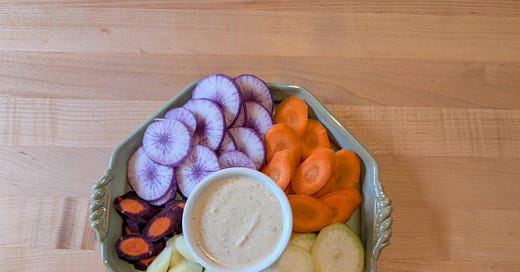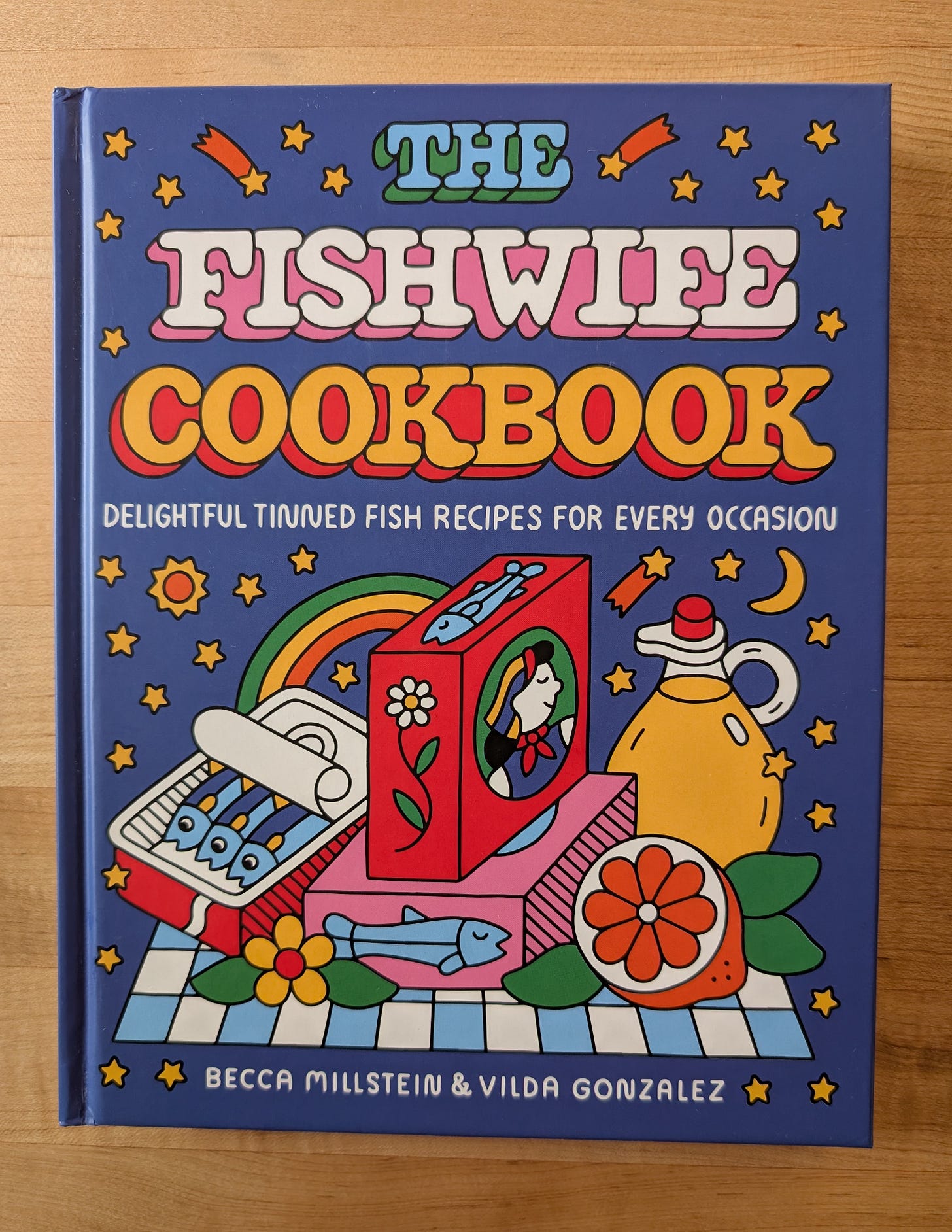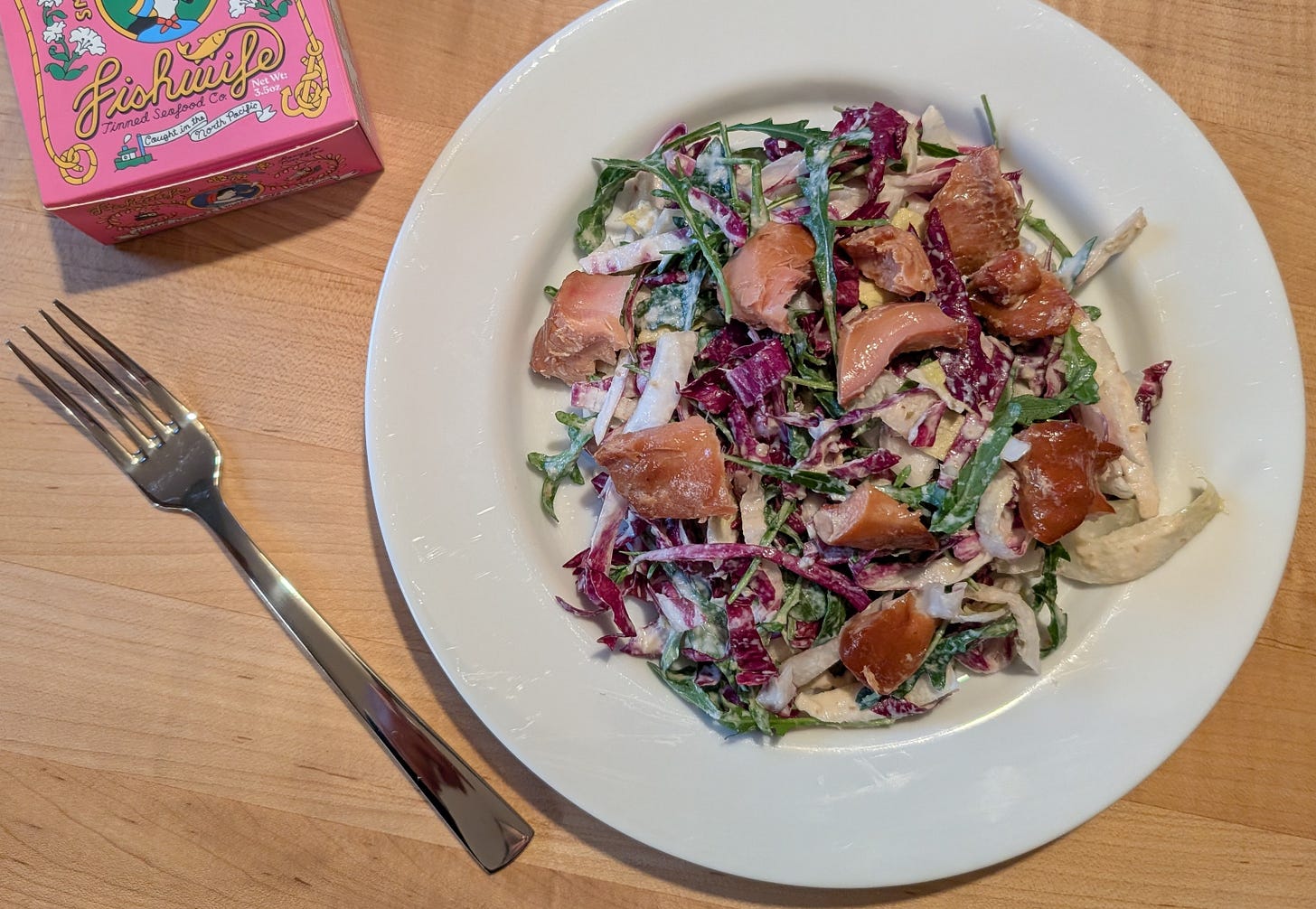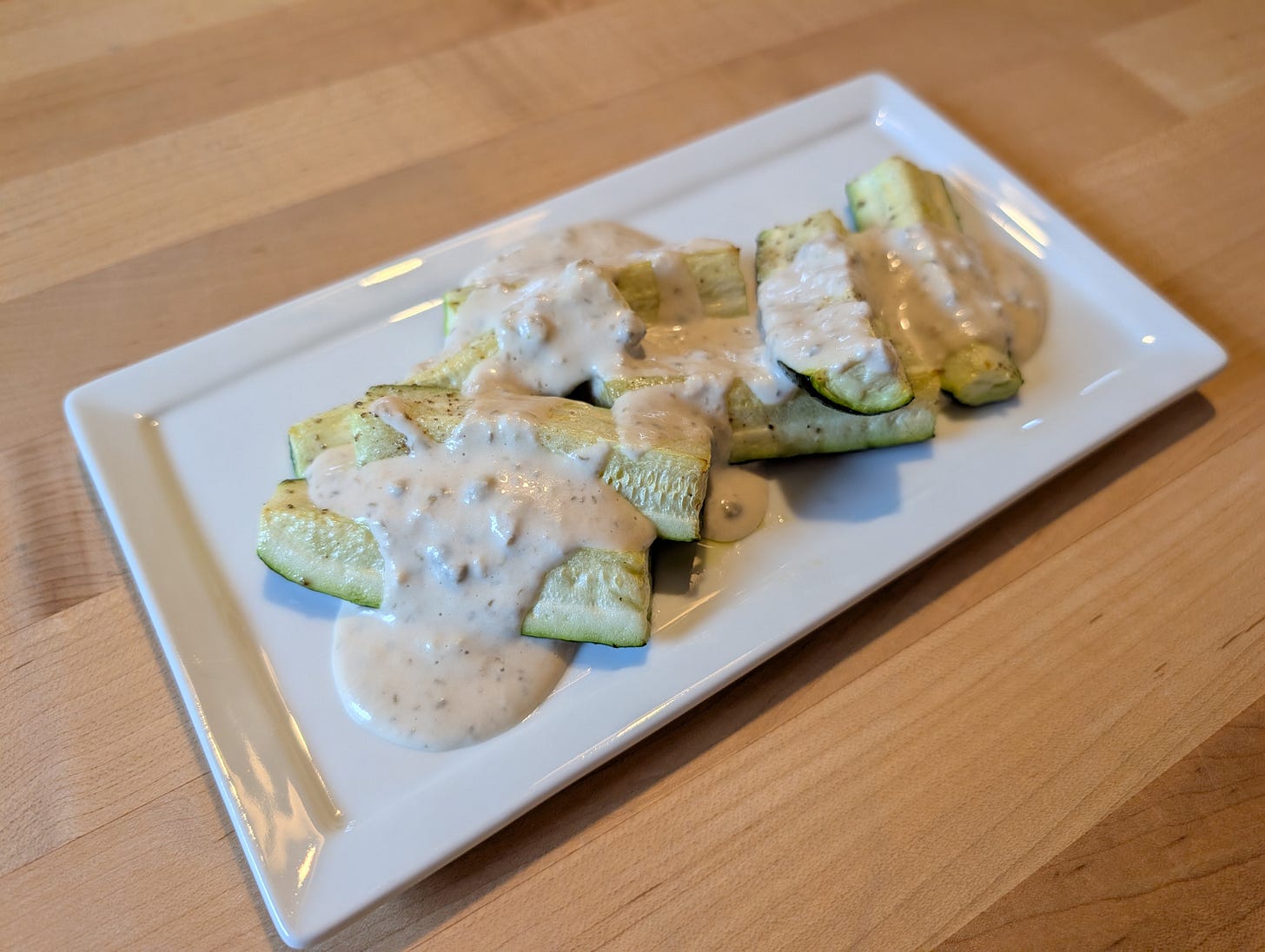Playing around with tonnato sauce
A traditional Italian tuna sauce that has lots to offer, plus the new The Fishwife Cookbook
I did not have “tonnato rabbit hole” on my calendar for this week, but that’s what ended up happening. Thankfully it was not nearly as deep a dive as some of my research adventures take me—in part because my goal was to have something to share with you this week. And tuna-based tonnato sauce ended up being that thing.
It was sparked, in part, by looking through the recipes in the new The Fishwife Cookbook that I picked up last week. A bit more on that book below, but one of the recipes that stood out as I looked through was the Tonnato with Charred Broccoli, Pickled Onion, and Anchovy Breadcrumbs, since tuna sauce (tonnato) had crossed my radar somewhere else recently. In classic Italian cuisine, the sauce is served over thin slices of chilled veal—vitello tonnato, a preparation I’ve had and loved, but not one I see very often. That broccoli version is an enticing example of using the traditional sauce to spoon over something besides veal.
Having never made tonnato before, with veal or otherwise, off I went to check out a handful of recipes.
I first turned to a couple of the more traditional resources on my shelves. In her The Classic Italian Cookbook, Marcella Hazan says of Vitello Tonnato that it is “one of the loveliest and most versatile of all cold dishes. It is an ideal second course for a summer menu, a beautiful antipasto for an elegant dinner, a very successful party dish for small or large buffets.” Beauty may be in the eye of the beholder; others find the visual appeal more bland—though garnishes can do wonders. Her version of the sauce uses mayonnaise (which she insists be homemade), a can of Italian tuna packed in olive oil, anchovy fillets, olive oil, lemon juice, and capers.
The Cooking of Italy book in the beloved Time-Life Foods of the World book series offers a particularly snazzy presentation, as you’ll see in the photo below. This version of tonnato uses an egg yolk instead of mayonnaise, to be puréed with tuna, olive oil, anchovies and lemon juice, the mixture embellished with some cream and a splash or two of the veal cooking liquid. Capers are added last, not puréed with the rest.

A couple recent books offer recipes that inspire ways we might use tonnato sauce beyond its classic application. In her book Getaway, Seattle chef and restaurateur Renee Erickson swaps sliced tomatoes for the veal, citing inspiration from a meal she’d had in London. Her tonnato blends tuna (she likes a local water-packed tuna) with anchovy, garlic, capers, olive oil, mayonnaise, and lemon juice.
And in the recent Hog Island Book of Fish and Seafood, there’s a recipe for Tuna “Tonnato” Penne that tosses penne in a sauce based on the familiar combination of tuna, anchovy, capers, lemon juice, garlic, and olive oil. The Fishwife version of tonnato uses their tinned albacore tuna and anchovies, with aioli, capers, lemon juice, Dijon, and black pepper.
I could look at five or ten more tonnato recipes and would surely see more slight variations with that similar foundation of canned tuna, anchovies, capers, garlic, lemon juice, and some combo of oil/egg yolk/mayo for body and creaminess.
As with so many recipes of this kind that have traditionally-rooted ingredients, individual interpretations often rely on specific choices for those ingredients. Among those above, the tuna called for includes water-packed albacore and oil-packed from Italy, the capers unspecified or “preferably salted”, the smooth texture aided by egg yolk and oil or mayonnaise. Some add cream, stock, other small embellishments. But tuna-anchovy-capers-garlic-lemon juice seem to be constants.
The mixture can serve as a dip for vegetables, adjusting its consistency if needed to be thick enough—I found the recipe below was fine as is for dipping. I also found it ideal to use as a boldly-flavored dressing; thicker than a vinaigrette, it clung nicely to the greens. I used radicchio, arugula, and Belgian endive for their contributions of flavor, color, and texture; it might be a bit much to serve with more delicate greens. But who knows? I invite you to play around the options and get back to me on your favorites.
A Note on Capers
Capers took a while to grow on me, as I mentioned in an earlier post with a swordfish piccata recipe. In the decade or so that I’ve been more happily adding capers to things I’m cooking, it had always been from one of those thin jars, packed in a brine. The jar I’ve had in my fridge lately, however, is much larger and full of capers packed in salt.
My husband picked it up on a shopping trip to Seattle’s beloved ChefShop. Well, anyone can shop at ChefShop via their website, but we’re lucky to have their HQ store to visit too, so many outstanding, delicious things to choose from. I often pick up elegant marmalade, farro, tahini, harissa, maybe a treat like torrone or fancy cookies of some kind. And whatever other random delight jumps in my basket.
My husband took Eliza’s suggestion at ChefShop to get me salted rather than brined capers, and I’m so appreciative of the introduction. It does mean an extra step of rinsing off the salt and soaking the capers in water for 10 minutes or so before using, but that’s a breeze. And worth it. The vinegary brine tempers the flavor of the capers a bit, while the salted capers have a more pronounced flavor. Having the salted on hand now takes my caper fandom up a notch and I’ve really enjoyed having them for tuna salad and Green Goddess and sauces and such.
The Fishwife Cookbook
Writer Becca Millstein talks of being introduced to tinned seafoods in Lisbon when she was 21 and visited the city while spending a fall living in Granada. I can relate to her fascination with the shops dedicated to tinned seafoods. She writes of looking through the window to see “rows of colored boxes on the shelves, and at first I thought it was a toy shop.” Maybe not a toy shop, but definitely a candy-store experience for those of us who love tinned seafoods. I had a most memorable experience shopping at Conserveira de Lisboa a decade ago, which I wrote a bit about here.
Not everyone who’s dazzled by those shops packed with outstanding tinned seafoods goes on to co-found a tinned seafood company. But that’s where the experience led Millstein, with the launch of Fishwife in 2020. Their offerings include a range of tinned seafoods sourced from different seafood destinations around the globe. “In this book we’ve tried to honor each cannery’s work and invite the dishes to complement and bring forth the artistry in the tin.”
Recipes in the book include a number of familiar favorites presented with a Fishwife twist, such as a frittata, pastas, deviled eggs, and chowder. And there are plenty of recipes that inspire with interesting ideas such as savory miso oats with chili crisp salmon, sardine tapenade on toast and lamb Bolognese with anchovies (which was one of the first pages I flagged for making sooner than later).
There’s a lot to love about just popping open a tin of great seafood to enjoy very simply: on crackers with an accoutrement or two, or straight from the tin. This book celebrates those simple joys, too, with the “Just a Quickie” section. And it goes on to be sure we never tire of ideas for incorporating tinned seafoods from breakfast through midnight snack.
Tonnato Sauce
I decided to whip up the same recipe twice: once with the less expensive everyday items, and once with the pricier imported/small batch items. I was curious to see how much difference I noted between the two. The more luxe version—with a Spanish oil-packed tuna and salted capers—did have a noticeably richer, more pronounced flavor. The less luxe, using Kirkland water-packed albacore and brined capers, was still quite good, milder and less robust, which could be a plus for some folks. The mix-and-match element of choosing from a couple options with some ingredients allows you to work with what you have on hand, what you prefer, and your budget.
There are so many can/jar sizes for tuna, you might be using some or all of one or two—which is why I give a rough cup measure as a ballpark. My embellishment is a pinch of lemon zest for a touch more zing. The sauce should be plenty salty as is, though if you find it lacking, add salt to taste. As is often the case with blended sauces like this, the flavors will meld and develop after sitting for a bit, even better the next day. It’s great if you can make it at least a couple of hours ahead and refrigerate for a spell before using.
1 to 2 cans or jars (6-7 ounces total) tuna, drained and flaked (about 1 cup)
1/2 cup mayonnaise
1/4 cup olive oil
1/4 cup freshly squeezed lemon juice
2 tablespoons capers, brined (drained) or salted (rinsed, soaked, and dried)
3 to 4 anchovy fillets, to your taste
2 cloves garlic, chopped
Pinch finely grated lemon zest
Combine the tuna, mayonnaise, olive oil, lemon juice, capers, anchovy, garlic, and lemon zest in a food processor and process until smooth, scraping down the sides as needed. Transfer the mixture to a bowl and refrigerate until ready to serve.
Makes a generous 1 1/2 cups
Here are a few ways I put that sauce to good use:
as a dressing for radicchio, arugula and Belgian endive; the salad was delicious as is, made even more delicious—and more substantial—topped with chunks of tuna. I happened to have a can of Fishwife’s smoked albacore tuna, which was divine; any tinned tuna you like will be great.
as a dip for some beautiful vegetables from last week’s CSA delivery
and drizzled over roasted zucchini, not the prettiest but it was tasty; I’d love to try it with roasted cauliflower, broccoli, green beans, I bet it’s great with many roasted vegetables.










Hard boiled eggs!!! Of course that's another great candidate for partnering with tonnato sauce. I'll be trying that sooner than later.....
I love the “tomato tonnato” that Erickson recommends! Been seeing that at a lot of restaurants and it’s a favorite to make at home.